A Moment of Discovery
with Will Miller and Ben Lumsdaine
Will Miller is a Chicago-based musician, composer, producer, and the mind behind Resavoir. His studio credits include work with SZA, Chance The Rapper, Whitney, and more. Today he is answering questions about the latest Resavoir record.
Will is pictured above at his former studio at Workshop 4200, an old Hammond organ factory on Chicago’s Northwest side. Photo by Scott McNiece.
Ben Lumsdaine is a musician, composer, and producer who has engineered and played on multiple International Anthem releases over the last few years. His own album Murmuration Without End was released by IARC on December, 8 2023. Today he is asking questions about the latest Resavoir record.
Ben is pictured above at Chicali Outpost. Photo by Ariana Lebedev.
BEN LUMSDAINE:
Did you make any conscious decisions to operate differently on this new Resavoir record? Did you think about it differently from the first record, conceptually?
WILL MILLER:
The only conscious change that I made is that I knew that I did not want to get a band in the studio all playing together.
BL: Okay, that’s cool. That’s kinda what I heard. That first record–was most of that stuff based around live performances? And you were kind of just cutting stuff up after the fact?
WM: I’d say it was half and half. Half of the songs on the first record were like, I had sketched out some demos and then we went to the studio as a full band and knocked it out. Maybe did some additional overdubs, and the rest of the songs on that first record are just, you know, computer experiments and homes studio vibes. A growing-over-time sort of thing.
BL: What do your demos sound like, that you would bring to a band? How fleshed out are they?
WM: Hmmm, I would say “Taking Flight” was very fleshed out. I remember making that on Garage Band and having the beat exactly as they ended up playing it, and the bassline, and even a piano part. You know, just already knowing where a certain flourish was gonna happen. For that one it was pretty cut and dry, and it’s maybe the most traditionally-minded song in terms of the form and the structure. A melody, tenor saxophone solo, melody sort of situation....but on this new one, I’m trying to think of the demos...I guess they’re all demos.
BL: Demos don’t really exist anymore.
MW: Yeah, exactly.
BL: It’s so easy to get good ideas down that sound usable that it just becomes the recording.
WM: “Plantasy” is a demo and I remember thinking would there be any point in trying to redo this in a studio? And even tried to cut a version of it in the studio and knew immediately it didn’t feel right. I think so much of the beauty of everyone having recording equipment these days, and having access to recording equipment is that you can capture the moment of discovery.
BL: Oh yeah.
WM: And that’s something that you weren’t always able to do back in the day, and that’s why songs were written the way they were. You write it on a piano or a guitar or something, bring it into the band, capture it in the studio, boom. You know? But now you can conceive the idea and capitalize on the momentum that you have creatively with the idea. The best songs, or the ones that I feel most proud of myself, are the ones where I conceive the idea and then fully flesh it out and try to take it to the finish line in the next couple hours. And then do some fine tuning and try to maybe add some deliberate layers that need to happen. With this new record there’s definitely a bunch of demos on there and the ones that don’t sound like demos are obviously more meticulously approached.
BL: How do you resist overworking? Cause I love that idea. There is so much momentum that you can get from, like you described it, capturing the moment of discovery. But then I find myself, not always but often, second guessing, being like “alright I loved this idea, but surely this can’t be as good as it’s supposed to be because it’s the first draft.”
WM: Right!
BL: So how do you resist that temptation?
WM: I think it’s not wanting to ruin a good thing that you have going. With this record I think it was a little more deliberate to leave some of the songs open-ended. I could definitely hear other things happening. More melodies, you know, but I also just enjoy the openness of it. I thought damn, well, if I really enjoy the openness of this then maybe someone else is gonna fuck with that, and they’re gonna hear it their own way and be inspired by that.
BL: That’s the reaction I had. I loved that a lot of the ideas are short. It’s just kind of like “hey, here’s the statement. And now it’s done.” And in some other universe it continues on, but it doesn’t have to. It’s a complete idea, and it just can be that, and you don’t have to turn it into a suite, or whatever else. It’s kinda refreshing.
WM: That was definitely my intention, and I think because of the fact that I had this limitation of no live band, my hope is that when it comes time to play the music live that will bring a different energy to the equation. And the show will inherently have to be different from the record, which I think is exciting. I don’t like going to a show when the show sounds exactly like the record. There’s no fun in that. Even though I think maybe that’s what everyone wants these days, but I don’t want that.
BL: Right, it can be impressive. I mean, I guess it’s fun to hear a song you love really loud.
WM: [laughing] totally.
BL: But I’m with you, man. I’d have a better time enjoying it by myself than in a crowd usually anyway, so I’d rather just listen to the record at home. [shifting gears] It seems like there’s a lot less horn on this second record, or I was thinking that and then, looking at the credits, it looks like there’s actually just a lot more EVI [Electronic Valve Instrument].
WM: There is!
BL: I usually have such a beef with them. I’ve never heard anyone use those with any good sounds. It feels like such a waste. I’m sure there’s people doing it and I’m just not aware of it, but most of the times I’ve heard a saxophonist use an EVI it’s just these corny sounds. Like Michael Brecker shredding on some [starts making some corny mouth sounds] ya know?
WM: [laughing] yeah, yeah.
BL: Just the “male voice” patch or some shit! But I was looking at the tracks [on the new Resavoir album] and I don’t exactly know what is a synth, and what is the Electronic Valve Instrument, but it sounds like you were probably triggering some Moog-ish situations with that thing? Am I close? I’m just kind of guessing.
WM: The EVI was from my big pandemic Ebay-risky-purchase period. I got really lucky and I found one from a vintage seller who said the light turned on, but they didn’t know if it worked. A vintage store in Ohio where everything else on their page was like dolls, and furniture, and things like that. It’s a Crumar vintage analog synthesizer. It’s the first breath-controlled synthesizer of its kind, so it has the most pure, beautiful sine wave that is just so buttery and gorgeous sounding.
BL: Yeah, shit! I’m looking at it now. Wow!
WM: It’s the OG! There’s no MIDI or anything on there. I got it modded to have a CV [Control Voltage] Out, but I haven’t found much of an application for that yet. But just the pure, raw analog synth sound on it is so gorgeous, and so I just got really captivated by that and also really enjoyed the limitation that it imposed on me. I was completely unable to “shred”, or just do the muscle memory things that I’ve developed from playing the trumpet for so long. I was forced to really slow my ideas down and really play thoughtfully and intentionally and I think for that reason I really enjoyed that switch that it kind of forced me to make.
BL: That resonates with the compositions too, that idea of a sort of minimalism and restraint. Not overworking an idea. It makes a lot of sense. Man, that so sick. So that is the sound that I’m probably hearing.
WM: Yeah, definitely. And I wanted to try and use that sound as – you know, great albums have sounds that tie the album together, that are making appearances across the record.
BL: It’s a diverse collection of material, but there is a real cohesion across the board that really does help. I also think that buying instruments is such a great way to get out of a box that you find yourself in.
WM: Accumulating new gear, and pressing ‘refresh’ on the studio is really important. Just the past couple days I’ve been going back and being like “okay I wanna get rid of these things, and pick up these things...”
BL: I’ve been in the same mode. I even just changed all my drumheads. Stuff I never do, just why not refresh the whole situation?
WM: You have to do it. So much inspiration can come from the sound of a new instrument, or just an instrument, period. If you aren’t feeling inspired by these things and they’re just taking up space, someone else will find inspiration from them and then you can get something new and be inspired by that. The people who I really admire and look up to in terms of being super prolific producers and writers are constantly getting new gear and recycling equipment, and I’m just so bad at that, and I take such a long time to make a decision on any new purchase.
BL: It took me like 6 months to buy a new pair of shoes.
WM: [laughing] Yo! I’m the same way! Musical equipment, clothing, literally any object that enters my life. It has to be such a deliberate decision and usually has to come out of necessity.
BL: Other than the EVI, were there other instruments that were inspiring? Did anything generate material for this record? Keyboard sounds?
WM: Yeah! The Korg Minilogue.
BL: Cool!
WN: Yeah, just a pretty affordable consumer synthesizer I picked up, and it has an arpeggiator that I was really fucking with. That’s on a couple songs. I was using it live with Trio Vibes, the trio I have with Lane Beckstrom and Jeremy Cunningham. There are two songs on the new record that were recorded in my side yard. And that’s using the Minilogue. And I also used it on “Robot Dreams”, and “Sunday Morning”, and “Sunset”, and “On and On”. That thing is the shit, and I love it, and I’m never going to get rid of it. It’s so cheap, man! It’s like $350 or something!
BL: You say that you wanted to avoid bringing a live band in, but there are a lot of people on all these songs. Was most of this just done piece by piece? Overdub vibe? Because there’s stuff that sounds like horn players interacting with each other. What was your approach with that?
WM: I’ve been thinking about this a lot. I feel like there’s three methods on this record. One of them is the demo, me alone in my studio catching a fuckin’ sick wave and just riding that shit and knocking out the track in like an hour and a half or two hours. And then there’s the second way, which is where we had a freely improvised session in the side yard with just me, Lane, and Jeremy and then took the best moments from that and chopped em up. “Mid Day”, for example is just raw, no overdubbing or anything. It’s just, front to back, us playing together for the first time since lockdown, in June of 2020.
BL: [surprised] Man!
WM: And then “First Light”–same day as “Mid Day” but a different improvisation–I cut the ending and looped it and sent it to Peter Manheim and he did this incredible percussion arrangement on it.
BL: Yeah, he did.
WM: And so I had this long thing, and [decided] what I wanna do is bring people in and just have them improvise along with us, first take, as if they were with us there, ya know? And so I did that with Ken [Leftridge Jr.], who plays saxophone and flute and bass clarinet on that song. He did a couple passes like that and then we isolated some moments where he matched the bass clarinet with what Lane played on the bass, note for note. It was the same thing I did for Matt Gold’s guitar. Put him in a booth, put him in headphones, press record, and have him vibe on it. And maybe give him another pass.
BL: That’s cool. That’s a good way to induce that “moment of discovery.”
WM: Absolutely.
BL: I guess it’s also a high pressure situation, but if you’ve got a cast of people you trust it’s not a problem. If you know they can dunk, first take, just let em rip.
WM: Exactly. [switching gears] So then the third version of the writing process is the demo that I take to maybe 50-60%. For whatever reason. Maybe I don’t consider myself the finest drum programmer, or the finest bass player [laughing], so I’ll sketch out some chords and maybe have a melody, and just kind of generally curate a vibe, and I’ll bring it to someone like Eddie Burns, who will do some crazy drum programming on it. Or send it to Lane, or bring him into the studio. Just piece by piece, try to build the song and flesh it out to be what I’m hearing in my head. They all kind of have shades of each other, in terms of the processes.
BL: Where are you recording these?
WM: Mostly at my studio, which was a huge comfort over the pandemic. I got this little, I don’t know, like 10x12 rehearsal space in this building. Maybe October 2020. Slowly built it out and got it vibey and dope in there. A lot of the drums were recorded in there. A lot of the horns. A lot of the synths were in there. It was just a nice place where I could go and have a daily practice. There’s some stuff that was recorded here in my apartment, but most of it is probably from my little shitty studio zone.
BL: I mean the recordings sound amazing, dude. Your self recording most of this stuff? What’s the rig? You got the nice collection of mics? Specifically, what do you record your horn with? Because I feel like it’s not easy to get a good recorded trumpet sound, to be honest.
WM:
Hmm! Yeah man! I got a Coles…2048? 1048?
BL: 4038?
WM: 4038! [laughing] yeah, I got one of those joints! I splurged on that, but you’re not really splurging on a nice mic because you’re going to be using that. It’s a tool of the trade. And it really fuckin leveled up my horn sound. And I was just actually looking at a different mic before we got on this call. An M49 clone.
[very specific microphone discussion ensues and continues for a while]
WM: Did you get an engineering degree? Or did you just pick up your engineering chops from being in studios and stuff?
BL: Jazz studies. I did a lot of session work and would just ask a lot of questions. Just tried to pay attention. I got a job at a studio in Bloomington, IN, Russian Recording. Which is where Dave [Vettraino] got a job after school. I was just going to intern. I wanted to learn how to record my own bands. But I just ended up getting hired and had to learn on the spot pretty rapidly. Mike [Bradavsky], the owner, was really generous with his knowledge.
WM: That’s beautiful, Ben. I’ve kind of wanted a similar experience for myself.
BL: It sounds like you’re having one. You have a room with microphones.
WM: Self-imposed. Interning with myself, but yeah. [laughs] I try to ask questions, but I wish I had a little more knowledge of circuitry and signal flow and that sort of stuff, because I feel like my setup is still very minimal.
BL: Minimal is faster. And easier. And also…it just doesn’t matter. It’s kind of blowing my mind that you recorded those trio things in your yard. It sounds amazing.
WM: I have to give a shout out to Jeremy Cunningham, because he definitely did some research on the best way to record drums, and was very meticulous about getting the mics set up just right over his drum set on those recordings, and I think that really paid off. And I thought we had maybe two overhead mics, a snare, and a kick until I got into mixing with Dave Vettraino and realized we only had a kick drum mic and one overhead.
BL: That’s crazy! You see what I mean? It just doesn’t matter! It sounds so crispy. I mean, it helps that Jeremy is, like, the best drummer in the world too.
WM: He’s really good at tuning his drums and getting them sounding really nice.
BL: Limitations create so much more inherent vibe. A 17-mic drum set up is usually just going to sound pretty wack. You really have to know what you’re doing if you’re using super nice mics, and a ton of them. Cause if you don’t know where to put them they reveal that a little more readily.
WM: That’s real.
BL: One nice mic is way more forgiving than putting up 8 nice mics.
[more very specific mic discussion]
BL: Having something you’re familiar with, and that is inspiring is a faster route to better ideas. I could buy some crazy fancy new synth, or try to get into modular or whatever, and just spend a year learning it instead of coming up with any actual ideas. I would rather just write a melody than open up the manual, you know? It’s valuable and fun to learn things, but there’s a time for both.
WM: It’s all about preparation, and that’s just something that you have to learn as a musician. You’re not always going to feel inspired to write, and so occupy that time with other shit that’s gonna help you facilitate making dope ideas and dope sounds when you do feel inspired.
BL: That’s very practical advice too….there’s still things you can do if you don’t feel inspired. Practice your instrument.
WM: Learn a song that someone else wrote.
BL: Yeah, totally.
WM: I don’t do that enough but I’m always glad that I did anytime I do. It’s important to take a peek behind the curtain and see what’s going on.
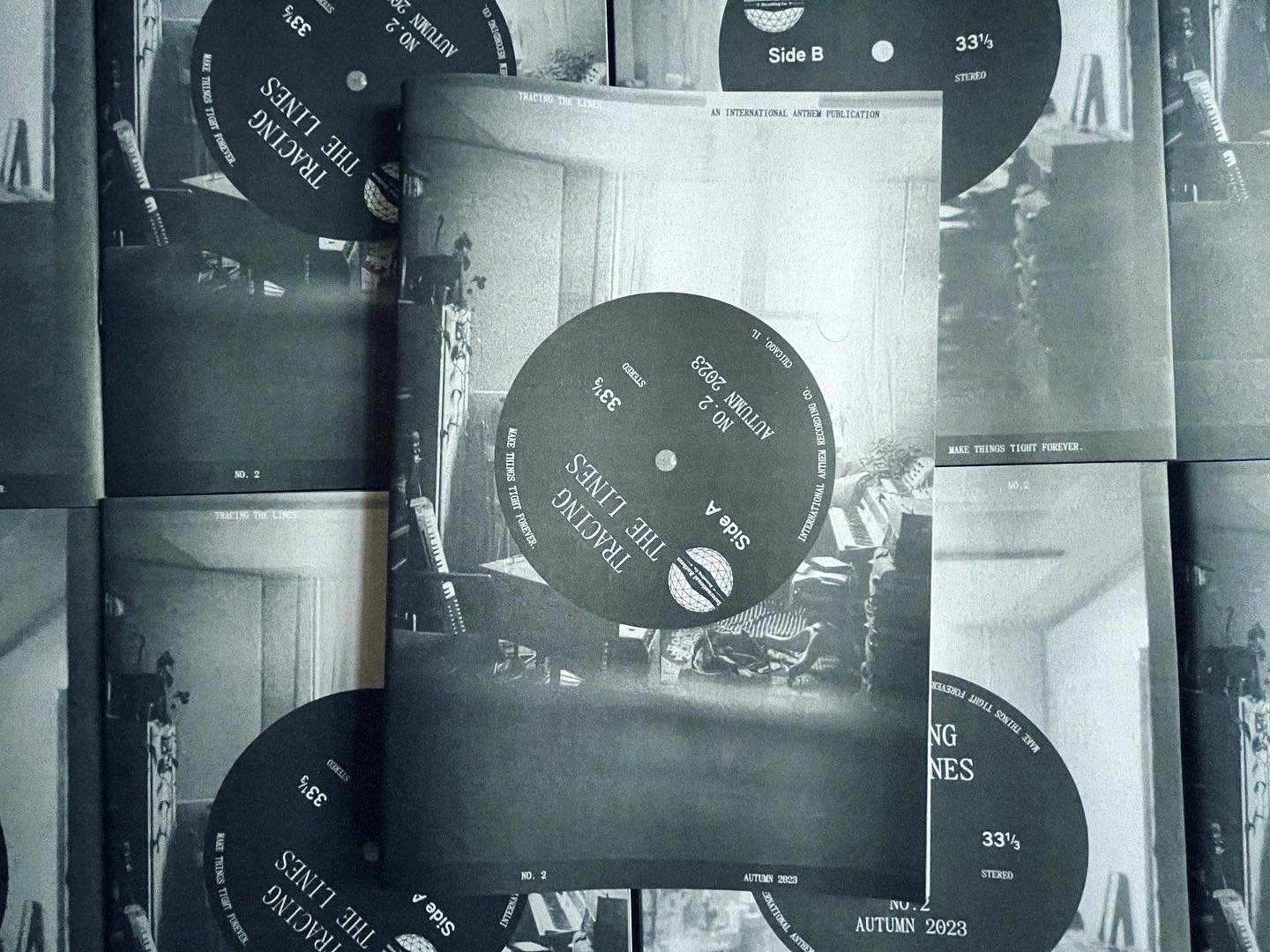
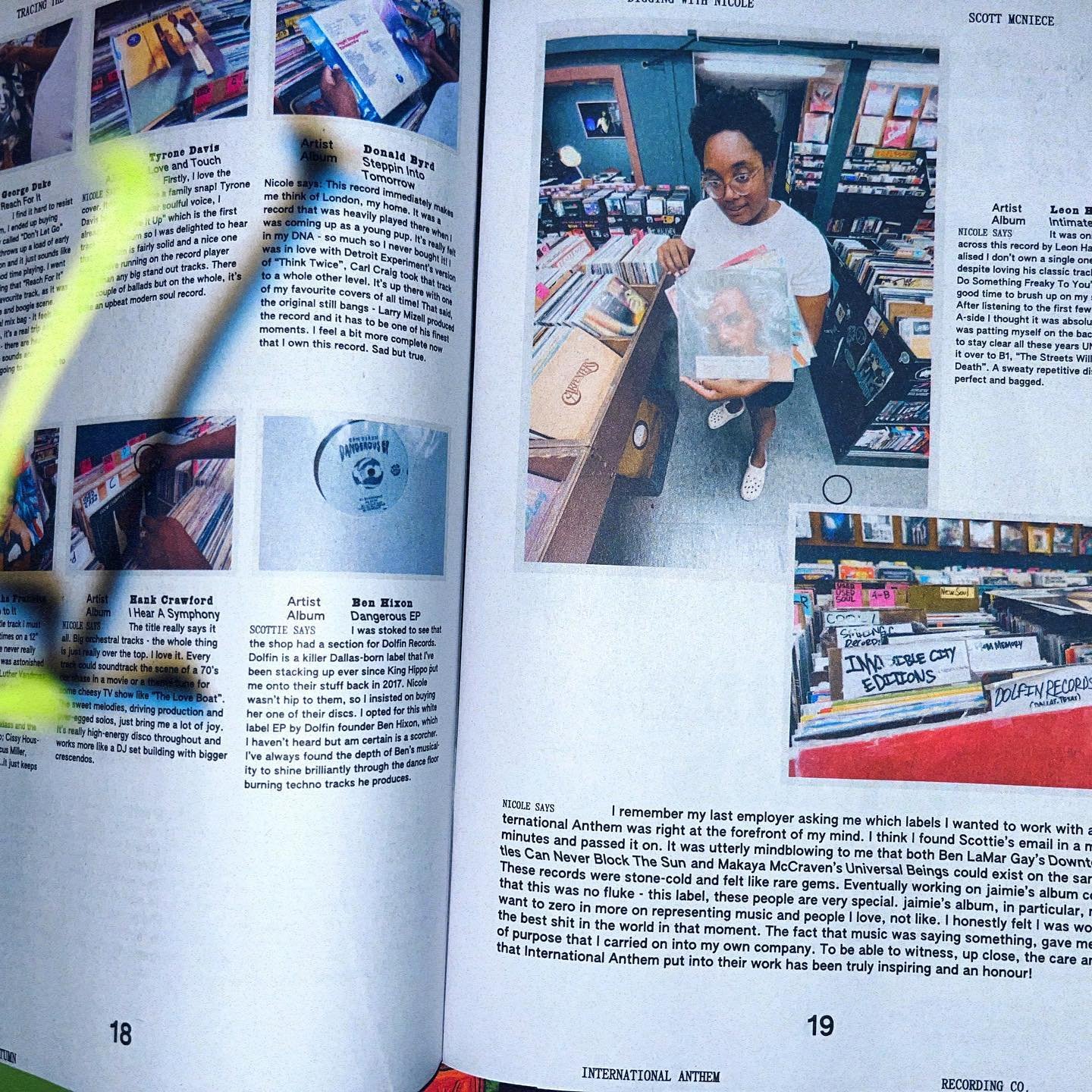
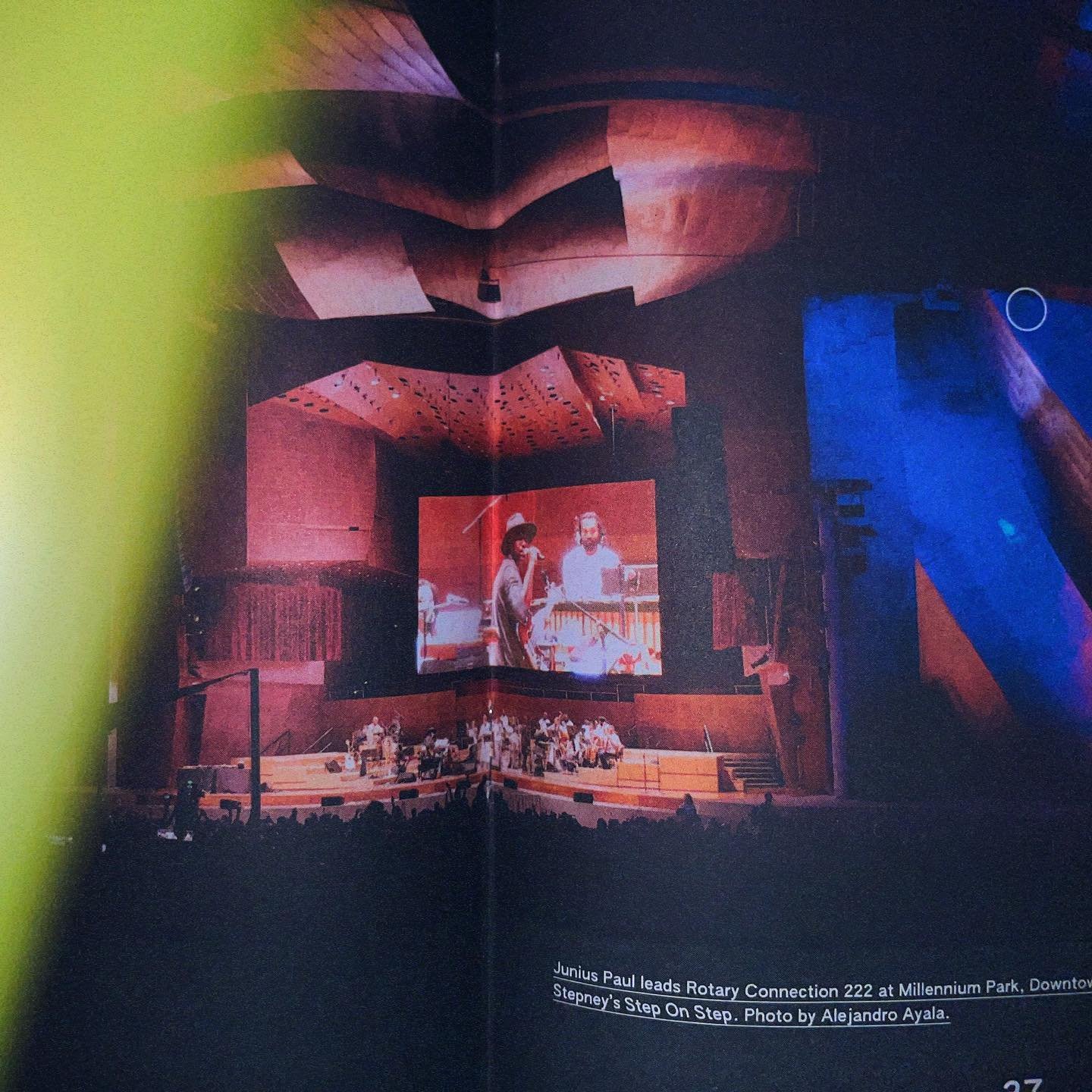
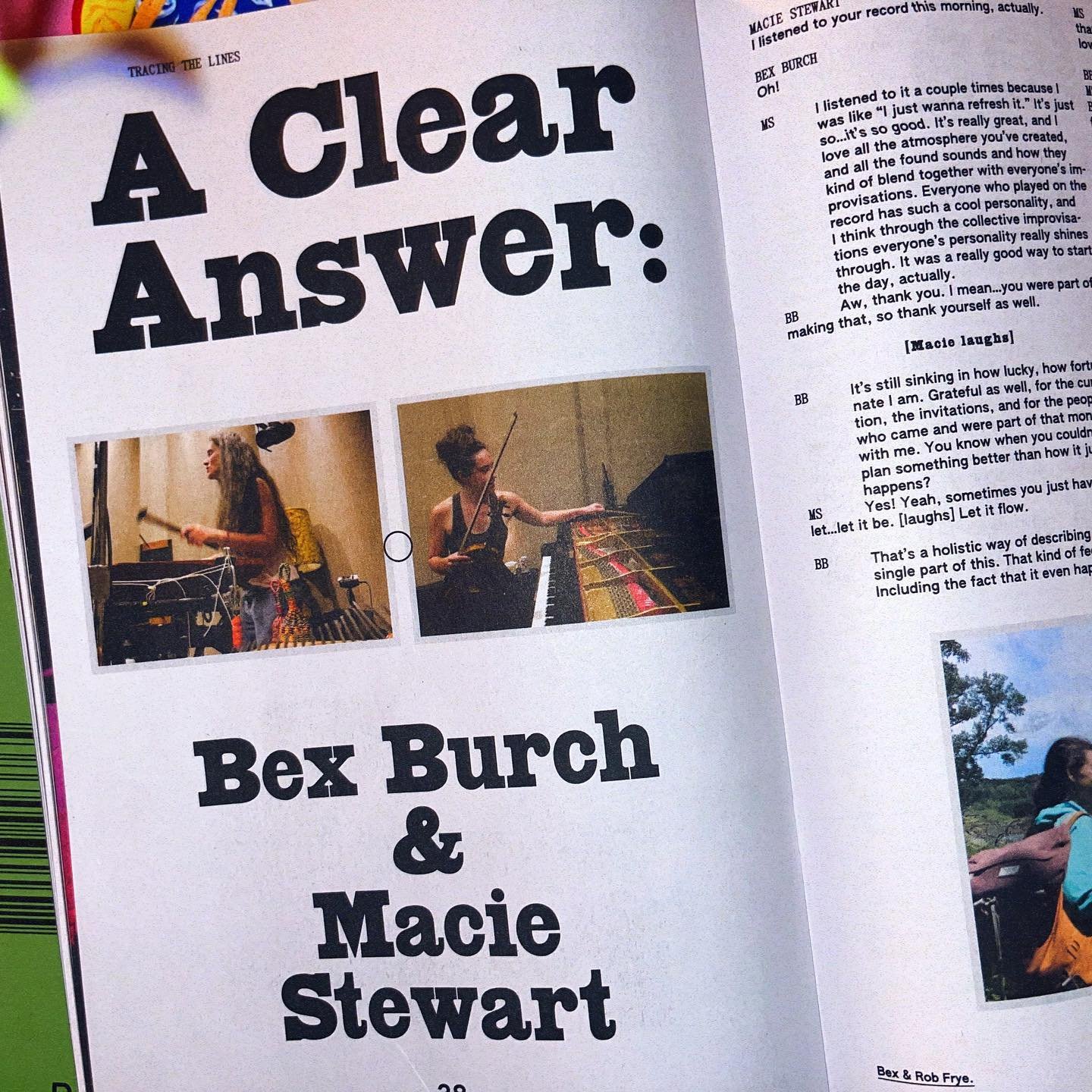
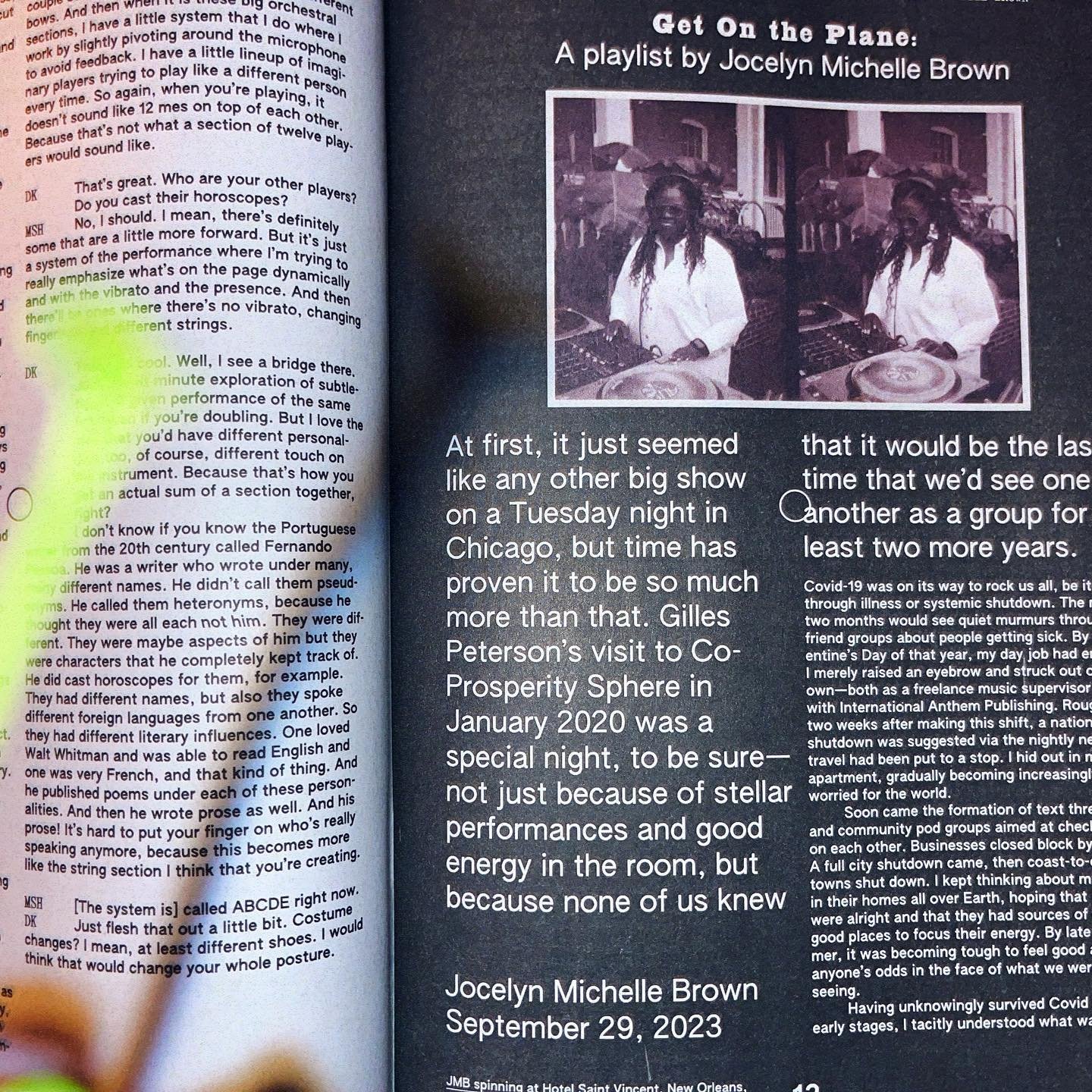
Tracing The Lines is a creative exploration of International Anthem Recording Co. and the community that surrounds it.
Issue #2
The 72-page 170x250mm newsprint zine, printed in the UK on 70gsm stock, was edited by David Brown and designed by Jeremiah Chiu with contributions from:
Alabaster DePlume, Alejandro Ayala, André 3000, Ariana Lebedev, Ash Knotek, Ayana Contreras, and more!




